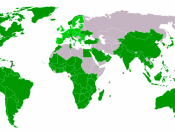World Cities are cities that act as control or command centres, transport and communication hubs, and often the headquarters of trans-national companies. (senior geography 2).
They can also be defined as a very large city that has outstripped its national urban network and become part of an international global system. The three dominant world cities are New York (United States), London (England), and Tokyo (Japan). Other categories of world cities include major and secondary. But they do not have the same influence as the three major world cities.
World cities have many major functional components in order for them to become a world city these include:
* Being a center of leading global markets in financial services, foreign exchange, investment capital, equities and bonds.
* Sites for most of the leading global markets for commodities and commodity futures.
* Sites for the concentrations of corporate headquarters of transnational companies (TNC), national firms and large foreign firms.
* Centers for specialized high order business services especially those associated with international activities in finance, accounting, law, advertising and property development.
* Sites of concentrations of the national and international headquarters of trade and professional organizations
* Sites of most of the leading Non Government organizations (NGO's) such as Amnesty international and Greenpeace. As well as intergovernmental organizations (IGO's) such as the World Health Organisation (WHO), the United Nations (UN) and the World Trade Organisation (WTO)
* World cities are the sites of the most powerful and internationally significant media and technology organizations, telecommunication companies and culture industries including art and design, film, TV and Fashion. E.g. BBC London and 5th avenue New York.
* World cities are also major tourist attractions.
In the 20th century trade between world cities increased dramatically beacause of the process of globalization and technological advances.
Globalisation refers...


